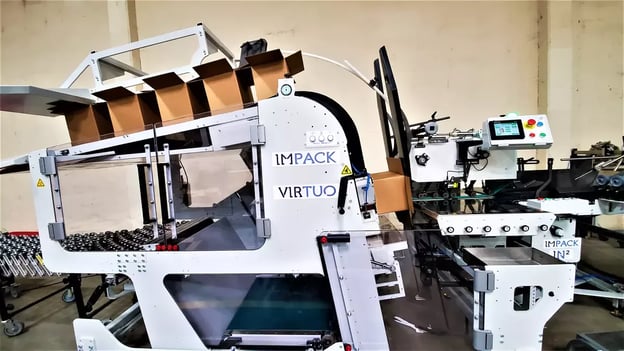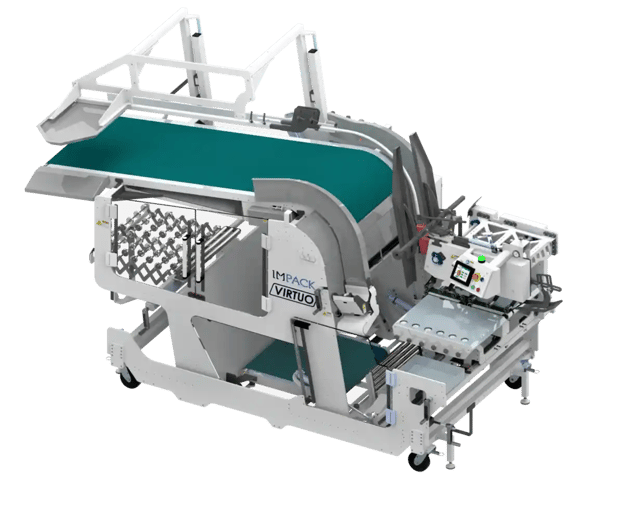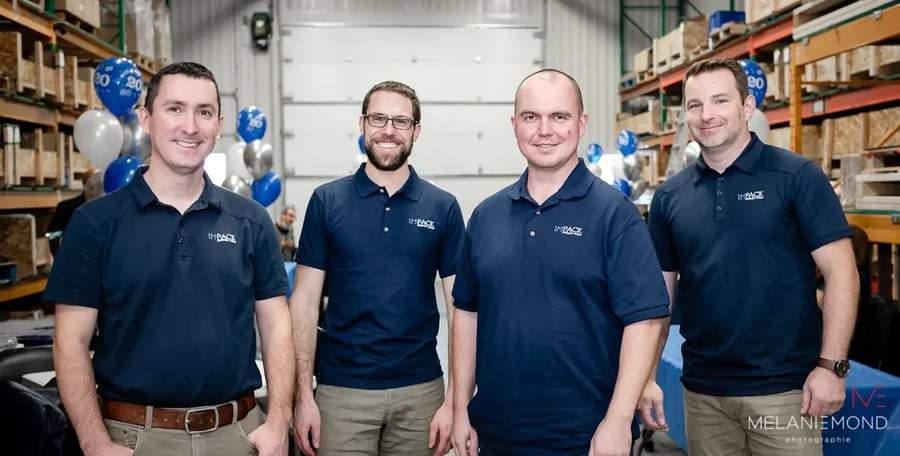Folder-Gluer Packers: What Level of Automation Is Right for You? [+VIDEO]
Are you considering investing in a folder-gluer packer or folder-gluer stacker?
8 min read
 Mathieu Tremblay
:
January 25, 2022
Mathieu Tremblay
:
January 25, 2022

Are you struggling to improve your folder-gluer's productivity?
Looking for ways to reduce your packing staff, increase your folder-gluer output, and reach higher packing speeds?
As the Deputy General Manager and Director of Production and Engineering at IMPACK, I have managed hundreds of projects that involve all kinds of packing systems with varying levels of automation.
What if I told you that you can increase your packing speed by 25%, 50%, or even 100%?
What if I told you that you can reduce your operators by 1 or 2 people, cut down on costs, and realize dramatic productivity gains?
It is possible and easily achievable.
How?
By automating your case packing process through installing a folder-gluer packer to your folding gluing line.

Last week, I covered ''What is a Semi-Automatic Packer and What Companies Is It Best Suited For?''
Today, we’ll talk about the Automatic packer: What it is, its pros and cons, and when it makes sense for your company versus when there are better options you should consider.
By the end of this ARTICLE + VIDEO, you’ll be able to decide whether an Automatic packer is right for your company or not.

First, it is important for you to know that all packing systems fall into one of the following four levels of automation:
Manual packing
Semi-Automated packing
Automated packing
Fully-Automated packing
In other words, there are Manual packing systems, Semi-Automatic packing systems, Automatic packing systems, and Fully-Automatic packing systems.
And by “packing systems” we are referring to folder-gluer packers, folder-gluer stackers, or any packing help/aid that is added to your folding gluing line to help you automate your case packing or bundling/stacking process.
🔍 Recommended:
If you’re considering adding a packing system to your folder-gluer but you’re still unsure about what level of automation your company needs, find out by reading “What’s the Difference between Manual, Semi-Auto, Auto & Fully-Auto Folder-Gluer Packers?”
If you’re interested in a Semi-Automatic packer, the article “What is a Semi-Automatic Packer and How Can It Improve My Packing Process?” covers everything you need to know about a Semi-Automatic packer!

A folder-gluer packer is a packing system that partially, or fully, automates your case packing process hence allowing you to improve your folder-gluer’s productivity, reduce the number of operators or packing staff required, cut down on costs, and reach top packing speeds.
A folder-gluer packer is installed behind the folder-gluer and after the pre-packer(s).
That is, a packer is installed at the end of the flow of the gluing line.


As we saw above, folder-gluer packers fall into 4 different levels of automation.
An Automatic folder-gluer packer (or an Automatic packer) offers an Automated packing process.
Just like a Semi-Automatic packer, an Automatic packer partially automates your case packing process.
That is, an Automatic packer offers you an Automated packing process where the machine becomes the key factor of the packing process and the operator is now limited to only performing background tasks such as feeding the packer with empty cases or managing full cases.
That said, and just like with a Semi-Automatic packer, the operator is still permanently present as part of the Automated packing process and required to operate the Automatic packer.
However, and unlike the Semi-Automatic packer, the Automatic packer offers a more Automated packing process with greater performance but less versatility.
In short, an Automatic packer is the next level of automation above a Semi-Automatic packer and just below a Fully-Automatic packer. It automates your case packing process up to a point but a human is still required to be present (although they are no longer performing primary tasks and are limited to background tasks).
IMPACK’s Automatic packer is the Virtuo packer.

🔍 Recommended: Interested in learning more about IMPACK’s Virtuo packer? Read the article “What is the Virtuo Packer & What Companies is it Best Suited For?”
High production speed: An Automatic packer’s biggest selling point is its high production speed. This is because an Automatic packer’s speed can only be influenced by the machine itself as humans are now limited to background tasks and can never be a bottleneck.
Consistent productivity: The main difference between a Semi-Automated packing process and an Automated packing process is the role of the operator. In a Semi-Automated process, the operator is the key factor of the packing process whereas, in an Automated process, the machine is the key factor. Thus, the speed and productivity of a Semi-Automatic packer is entirely dependent on the dexterity and skills of your operator. In contrast, the speed and productivity of an Automatic packer is not influenced by human limitations which makes the Automatic packer a machine that offers consistent productivity with performance that is easier to foresee and guarantee.
Ergonomics is less of an issue: Because the operator is limited to background tasks with an Automatic packer, ergonomics is less of an issue with an Automatic packer compared to a Semi-Automatic packer since these background tasks are not ergonomically challenging.
Possibility to upgrade your Automatic packer to a Fully-Automatic packer with IMPACK’s Automatic Case Feeder (ACF).
Possible to have a box turner that allows you to choose on which side to turn the boxes (left, right, straight through or 180 degrees).
Setup times are generally longer and more challenging than Semi-Automatic packers.
Most are fixed or if on wheels, they are harder to move.
Less versatile as they are dedicated to focused jobs.
The operator is still part of the payroll: Despite their involvement being limited, the operator is still there, and working hard, whether for efficiency or ergonomic reasons. Humans are still part of the Automated process.
Usually requires a larger footprint than Collecting Tables or Semi-Automatic packers.

Time for some complete and raw honesty:
The truth is, a lot of clients get very excited when companies propose and discuss Automatic and Fully-Automatic packers.
And it can be an easy sale for us, packaging equipment suppliers, driven by the client’s pure temptation of having a robot doing the whole job, but that’s the perception in theory.
In practice, things are very different, and we want to make sure that you’re aware of this before you commit to any packaging equipment supplier.
You can add as many automatic features as you want to a Semi-Automatic packer but the reality is that as long as the operator is actively involved in the packing process, it’s still a Semi-Automated process.
Your case packing process becomes an Automated process once the involvement of an operator is strictly limited to background tasks such as feeding the folder-gluer packer with empty cases or managing full cases.
Although their involvement is limited, the operator is still there. Humans are still part of the Automated process.
And if anyone tells you otherwise, they’re probably misinformed.
Whether for efficiency or ergonomic reasons, a human is still present and working hard in an auto process.
Yes — all the groundwork, including putting all the boxes into the case is now automatically done by the machine, but just like with a Semi-Automated process, the operator is still there in an Automated process.
They are still on site,
They are still part of the cost,
They are still on the payroll,
It’s the same person with the same job title under the same job description doing (more or less) the same job.
And this applies to IMPACK’s Virtuo packer or any of the other popular Automatic packers on the market like Bobst’s CartonPack 4, Heidelberg’s Diana Packer, WSI Global’s Express Pack, and Graphic West Packaging’s J-Pack.
So, here’s an interesting question for you:
If the operator is required for the operation of an Automatic packer – just like they are with a Semi-Automatic packer – and you’re capable of reaching the same speed of an Automatic packer with a Semi-Automatic packer, why would you pay a higher price for an automatic packer?
There is no folder-gluer packer on the market that can fully copy a human’s hand movements. It is so natural for a human to pick up a box out of the shingle when there’s a problem.
And admittedly, it’s just as easy to fancy the thought of automating the hand movements of an operator, but when you start thinking about the mechanics involved, you’re hit with the unfortunate realization that it’s virtually impossible for a robot to copy all those natural human movements.
You can argue that there are fully automated robots for palletizing that can imitate most of the human’s movements, and that is undeniably correct.
But it’s important for you to know that with those projects, the scope is very clearly defined, always the same, never changing, and always accurate and perfect.
What happens if a slight modification is needed?
The robot completely fails.
But a human will just adapt: There’s a box sticking out or pushed forward…a human can just fix it with their own hands.
You just cannot automate every action a human does.
We organize everything around the folder-gluer packer so that the process is as automated and efficient as possible, but we rely on the human to make it possible.
You can certainly attempt to imitate a lot of those human movements through automation, just like you can launch a spacecraft to Mars, but the question is: At what cost are you willing to do so?
Would you be willing to pay millions of dollars for a machine that is fully automated and perfectly dedicated with zero margin for error but yet has a complete lack of forgiveness towards more complex boxes or any adjustments?
This is where realism must be integrated into your decision-making process: There’s always going to be a tradeoff between versatility and performance.

Now that you have a better understanding of what an Automatic packer is, the benefits it can provide to your packing process, and its advantages and disadvantages, you’re probably wondering:
“Is an Automatic packer the best choice for my company?!”
The answer to this question all depends on your product mix, type of production, box configuration, individual needs, and a set of intertwined factors.
But I won’t leave you at just that.
You never had a packer or any packing help/aid before
You want to take your first step towards improving your folder-gluer’s productivity
You’re not sure of your production and have a very tight budget
You have complex boxes that require constant adjustments/quality control checks
You have very limited floor space
If your production meets several of the characteristics described above, and you’ve never had any “packing help” or “packing aid,” then a Collecting Table could be an excellent start.
Examples of the most popular Collecting Tables in the Western market include: IMPACK’s Packing Help Stations, Bobst’s Handypack GT, KBA Duran's Omega Pack Station, and Tünkers' FAS 480.
You have variable production runs
You have small to medium-sized boxes
You have a wide and diverse variety of box formats
You have complex boxes that require constant adjustments/quality control checks
Here, a Semi-Automatic packer could be the perfect solution for your company.
IMPACK’s Ergosa packer is our top sold machine and one of the only Semi-Automatic packers that exists, to date, on the market.
You have long production runs
You have medium to very large-sized boxes
You have a limited variety and similar box formats
You have simpler boxes that do not need constant adjustments/quality control checks
Here, an Automatic packer would be the ideal option.
Examples of the most popular Automatic packers in the Western market include: IMPACK’s Virtuo packer, Bobst’s CartonPack 4, Heidelberg’s Diana Packer, WSI Global’s ExpressPack, and Graphic West Packaging’s J-Pack.
You have all the automatic packer requirements listed above
You want to fully automate your packing process
You want to reach a zero-human operation (no humans involved)
You're interested in advanced monitoring and industry 4.0 functionalities
Here, a Fully-Automatic packer would be the best fit.
Examples of the most popular Fully-Automatic packers in the Western market include:
IMPACK’s Virtuo + ACF, Bobst’s Carton Pack 4 + optional case erector, WSI’s ExpressPack + optional case erector, and CSI Packaging’s I-Pack.
Do you have a better idea of what folder-gluer packer is best for your company?
Finding the right folder-gluer packer from the right supplier is no easy task, so I hope this article helps you make a more educated decision on your new machine!
Compare Automatic packers to Fully-Automatic packers and evaluate their pros and cons to discover what level of automation is best for your company.
Read “What is the Virtuo Packer & What Companies is it Best Suited For?” to learn all about IMPACK’s Virtuo Automatic packer and your available options of upgrading to a Fully-Automatic packer.
Get a detailed breakdown of the costs of IMPACK’s different packers by checking out “How Much Does a Folder-Gluer Packer Cost?”
And finally, find out what folder-gluer packer is right for your company’s production & budget by reading "How to Choose the Right Folder-Gluer Packer."
If you’ve got questions that you want answers for, contact us today!
We’d love to help and maybe even show you some of our different machines LIVE in action 😉.
![Folder-Gluer Packers: What Level of Automation Is Right for You? [+VIDEO]](https://impack.ca/hubfs/X22-039-1.png)
Are you considering investing in a folder-gluer packer or folder-gluer stacker?
![What is a Semi-Automatic Packer and How Can It Improve My Packing Process? [+ VIDEO]](https://impack.ca/hubfs/X21-057.png)
If you’re looking for ways to improve your folder-gluer’s productivity, increase your folder-gluer’s output, and reach higher speeds, you’re probably...

You and your competitors have 1 common goal: